Regional Integrated Energy Site Layout Optimization Based on Improved Artificial Immune Algorithm
Abstract
:1. Introduction
2. Site Selection Layout Planning and Design of Regional Integrated Energy System
2.1. Site Selection Layout Strategy
2.2. Data Preprocessing
2.2.1. Vertex Matrix
2.2.2. Edge Matrix
2.2.3. Weight Matrix
3. Site Selection Layout Planning Model
3.1. Assumptions
- The site selection and layout of integrated energy stations are greatly affected by climate, terrain and other environments. This paper conducts a reasonable primary election for the data points, and the subsequent calculation process does not consider the influence of the external environment.
- It is assumed that the scale and capacity of the integrated energy station can always meet the needs of different types of loads at each demand point.
- Considering its high initial cost, each integrated energy station needs to meet at least two types of load demands simultaneously. Each energy station can simultaneously supply different types of energy to different demand points.
- The same type of energy at a demand point can only be supplied by one energy station at most. Different types of energy can be supplied by the same energy station or by different energy stations.
3.2. The Objective Function
3.2.1. The Number of Integrated Energy Stations to Be Built
3.2.2. Integrated Energy Station Coverage Rate
3.2.3. Transmission Load Capacity of Pipe Network
3.3. The Constraint
4. Improved Artificial Immune Algorithm
4.1. Improvements
4.1.1. Initial Population Screening Mechanism
4.1.2. Population Renewal Mechanism
4.1.3. Bidirectional Crossover and Mutation
4.2. Test Function
4.3. Optimization Process of Regional Integrated Energy Site Selection Layout Based on IAIA
- Import basic data
- 2.
- Set algorithm parameters
- 3.
- Data preprocessing
- 4.
- Generate the initial population
- 5.
- Main loop iteration process
- 6.
- To form the parent generation group and update the memory bank
- 7.
- Program termination judgment
- 8.
- Create new populations
- 9.
- Perform step 5.
5. Results and Discussion
5.1. Basic Data
5.2. Test Function Verification
5.3. Verification of Regional Integrated Energy Site Selection Layout Optimization
6. Conclusions
Author Contributions
Funding
Conflicts of Interest
References
- Liu, L.; Wang, D.; Hou, K.; Jia, H.J.; Li, S.Y. Region model and application of regional integrated energy system security analysis. Appl. Energy 2020, 260, 114268. [Google Scholar] [CrossRef]
- Jia, H.; Wang, D.; Xu, X.; Yu, X.D. Research on some key problems related to integrated energy systems. Autom. Electr. Power Syst. 2015, 39, 198–207. [Google Scholar]
- Tian, Y.; Liao, Q.; Liu, D.; Zhu, Z.; Peng, S.; Xu, Y. Planning of urban distribution network considering the integrated energy supply-side reform. Power Syst. Technol. 2016, 40, 2924–2934. [Google Scholar]
- Li, L.; Jiajia, H.; Huazhen, C.; Chong, G.; Xu, Z.; Junxi, Z.; Wei, C. Distribution network planning strategy based on integrated energy collaborative optimization. Power Syst. Technol. 2018, 42, 1393–1400. [Google Scholar]
- Ranjan, S.; Abhyankar, A.R. An approach for site selection to integrate renewable energy sources based on power system parameters. In Proceedings of the 2019 North American Power Symposium (NAPS), Wichita, KS, USA, 13–15 October 2019; pp. 1–6. [Google Scholar]
- Drauz, S.R.; Spalthoff, C.; Würtenberg, M.; Kneikse, T.M.; Braun, M. A modular approach for co-simulations of integrated multi-energy systems: Coupling multi-energy grids in existing environments of grid planning & operation tools. In Proceedings of the 2018 Workshop on Modeling and Simulation of Cyber-Physical Energy Systems (MSCPES), Porto, Portugal, 10–14 April 2018; pp. 1–6. [Google Scholar]
- Chao, Q.; Dong, X.; Jiang, T. Optimization planning of integrated electricity-gas community energy system based on coupled CCHP. Power Syst. Technol. 2018, 42, 2456–2466. [Google Scholar]
- Xu, C.S.; Dong, S.F.; Wu, J.C.; Han, R.J.; Shou, T.; Li, J.B. Planning of energy station and pipeline considering topological characteristics of regional integrated energy system. Autom. Electr. Power Syst. 2020, 44, 74–86. [Google Scholar]
- Guan, L.; Cheng, P.; Tang, Z.; Chen, X.; Jiang, Z. Integrated energy station design considering cold and heat storage. Power Syst. Technol. 2016, 40, 2934–2943. [Google Scholar]
- Wang, X.; Sun, J.; Yi, W. P-median model based optimization of energy supply station sites and pipelines layout for integrated energy system. In Proceedings of the 2nd IEEE Conference on Energy Internet and Energy System Integration (EI2), Beijing, China, 20–22 October 2018; pp. 1–6. [Google Scholar]
- Yi, W.; Yu, Y.; Zhang, Y.; Li, Z.; Huang, Y. P-median model based optimal planning of energy station for regional integrated energy systems. Autom. Electr. Power Syst. 2019, 43, 107–113. [Google Scholar]
- Zhou, A.H.; Zhang, B.D.; Zhang, H.X. Power transformer fault diagnosis by using the artificial immune classification algorithm. High Volt. Eng. 2007, 33, 77–80. [Google Scholar]
- Pang, Q.L.; Sun, T.J.; Liao, L.; Qin, W.G. Artificial immune algorithm based faulty line detection method for indirectly grounding power system. Power Syst. Prot. Control 2009, 37, 27–31. [Google Scholar]
- Li, X.W.; Zhao, H.W.; Li, N.; Shen, X.D.; Wang, L.P. Optimal filter configuration for distribution network based on artificial immune algorithm. Power Syst. Technol. 2010, 34, 104–108. [Google Scholar]
- Meng, W.C.; Qiu, J.J.; Bian, X.M. Artificial immune algorithm integrated with chaotic optimization for economic dispatch of power system. Power Syst. Technol. 2006, 23, 41–44. [Google Scholar]
- Ping, H.; Song, C.; Jiang, J.Q. Application of self-adaptive mutation immune algorithm in logistics distribution. J. Inn. Mong. Univ. Natl. Nat. Sci. 2017, 32, 406–411. [Google Scholar]
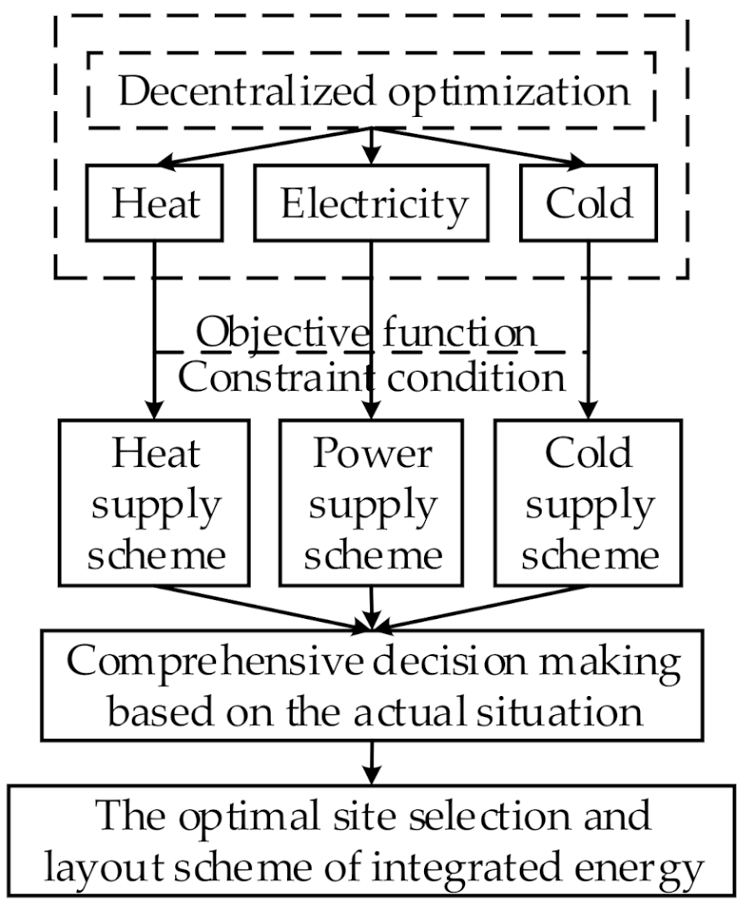
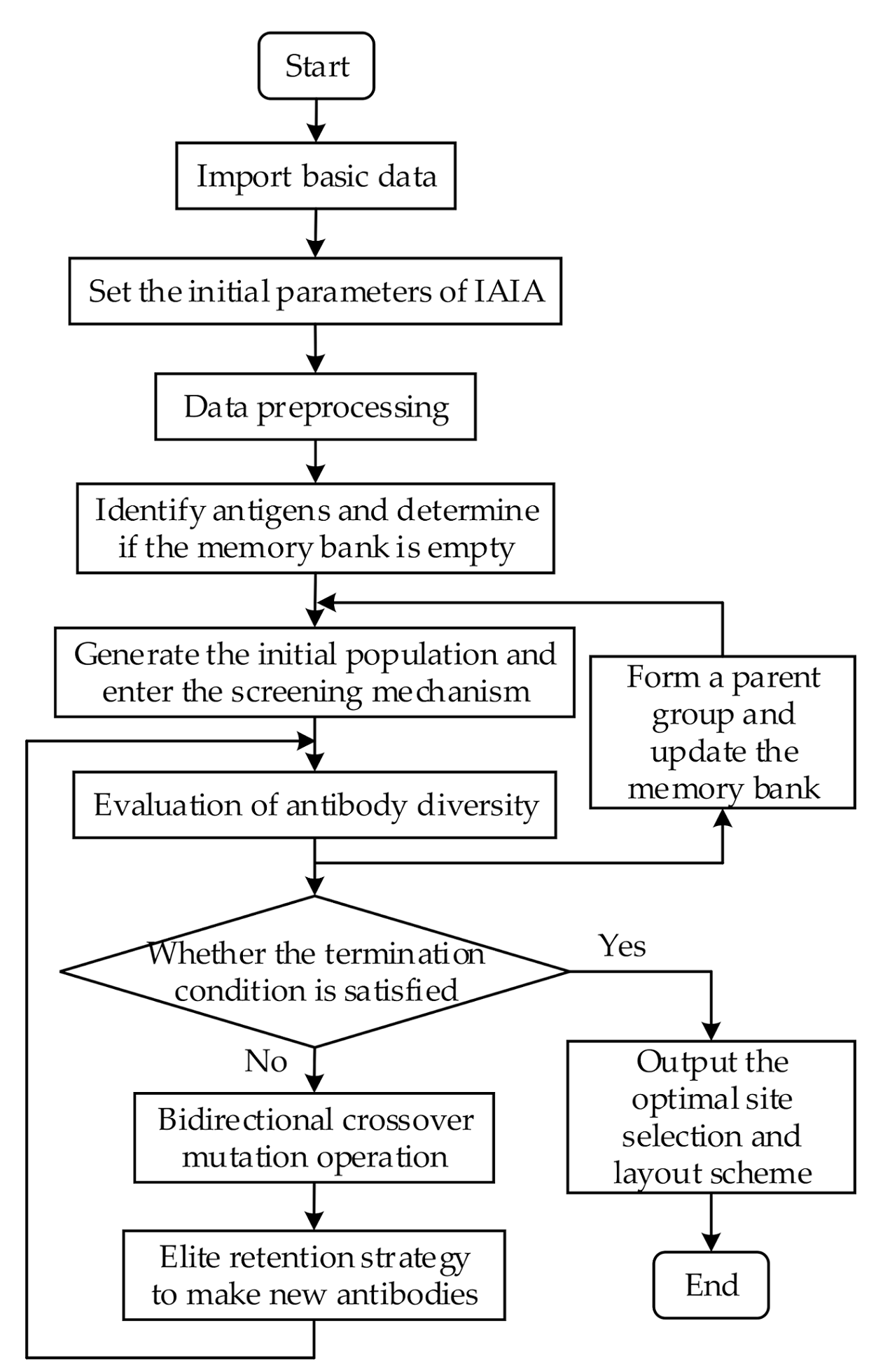
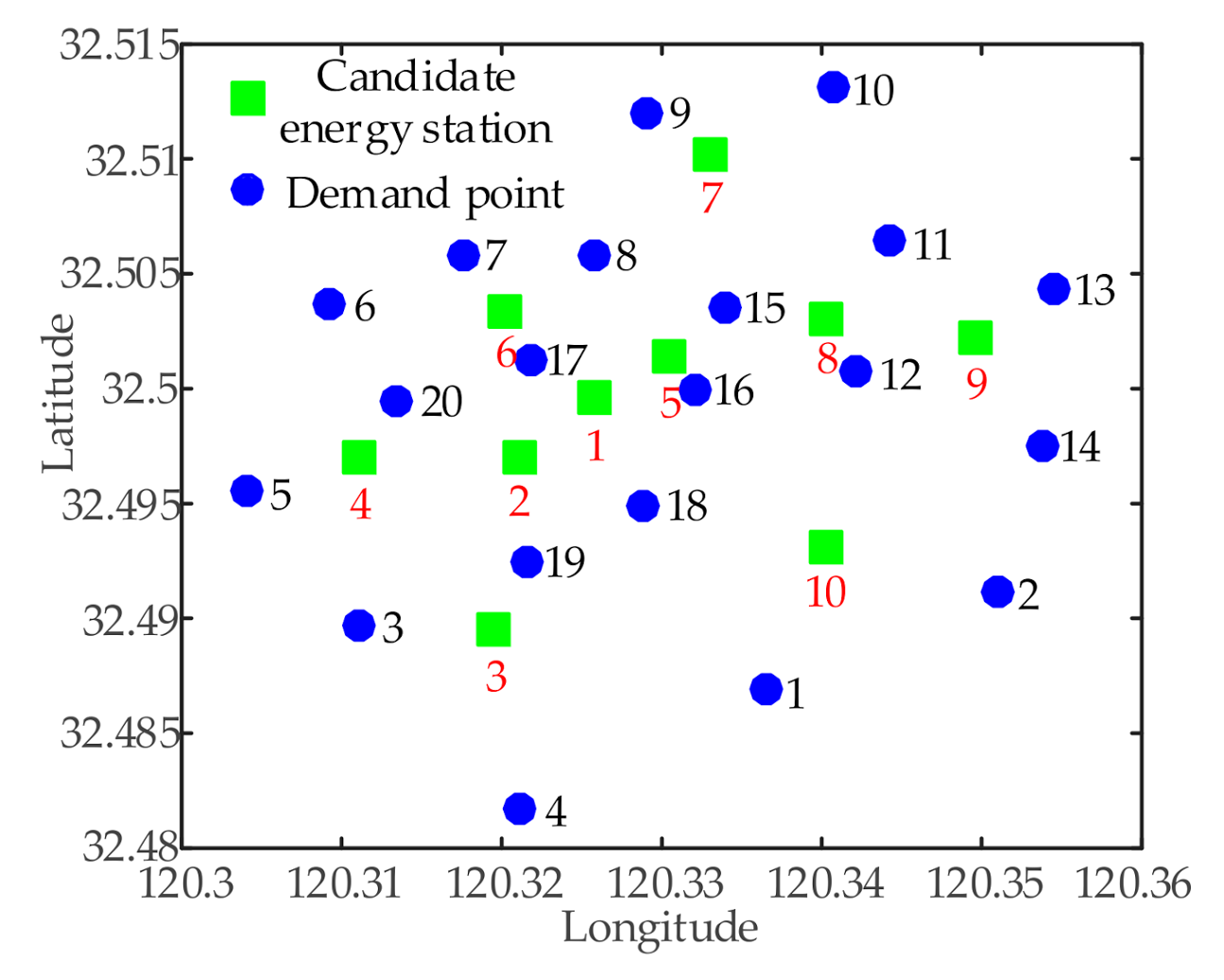
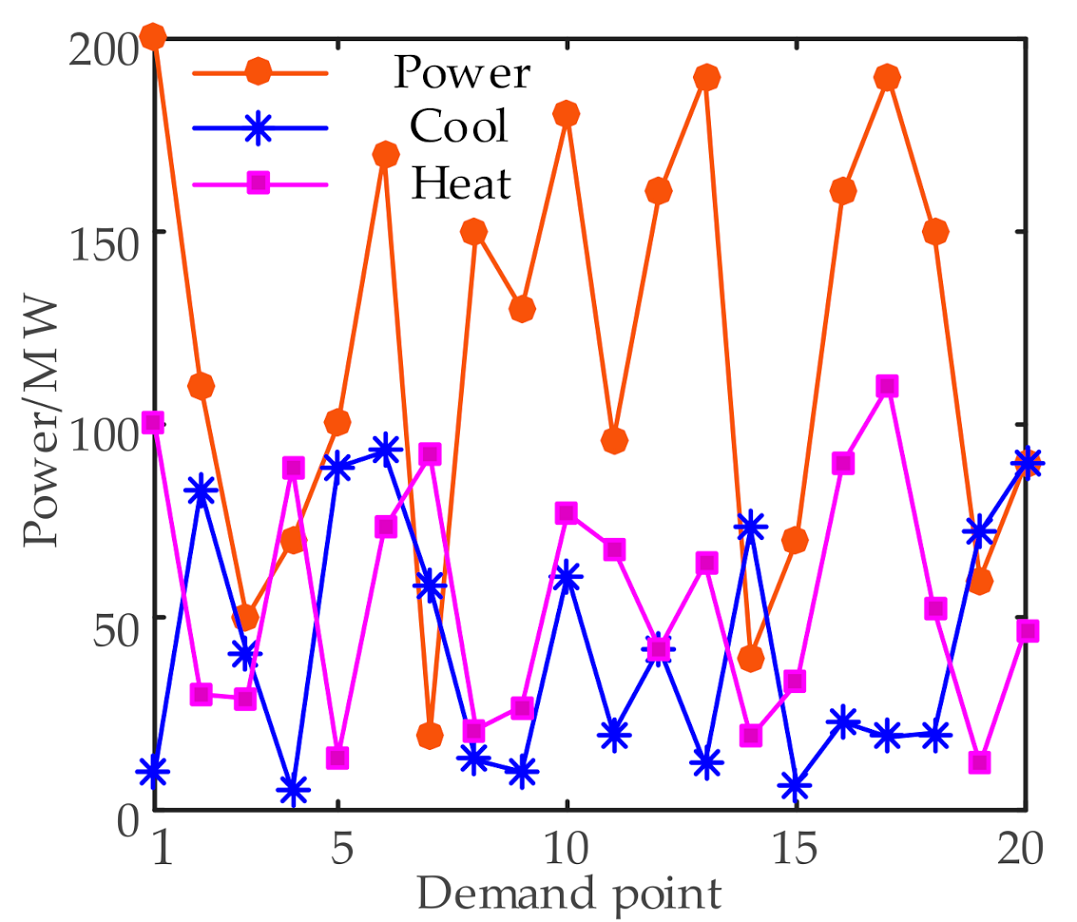
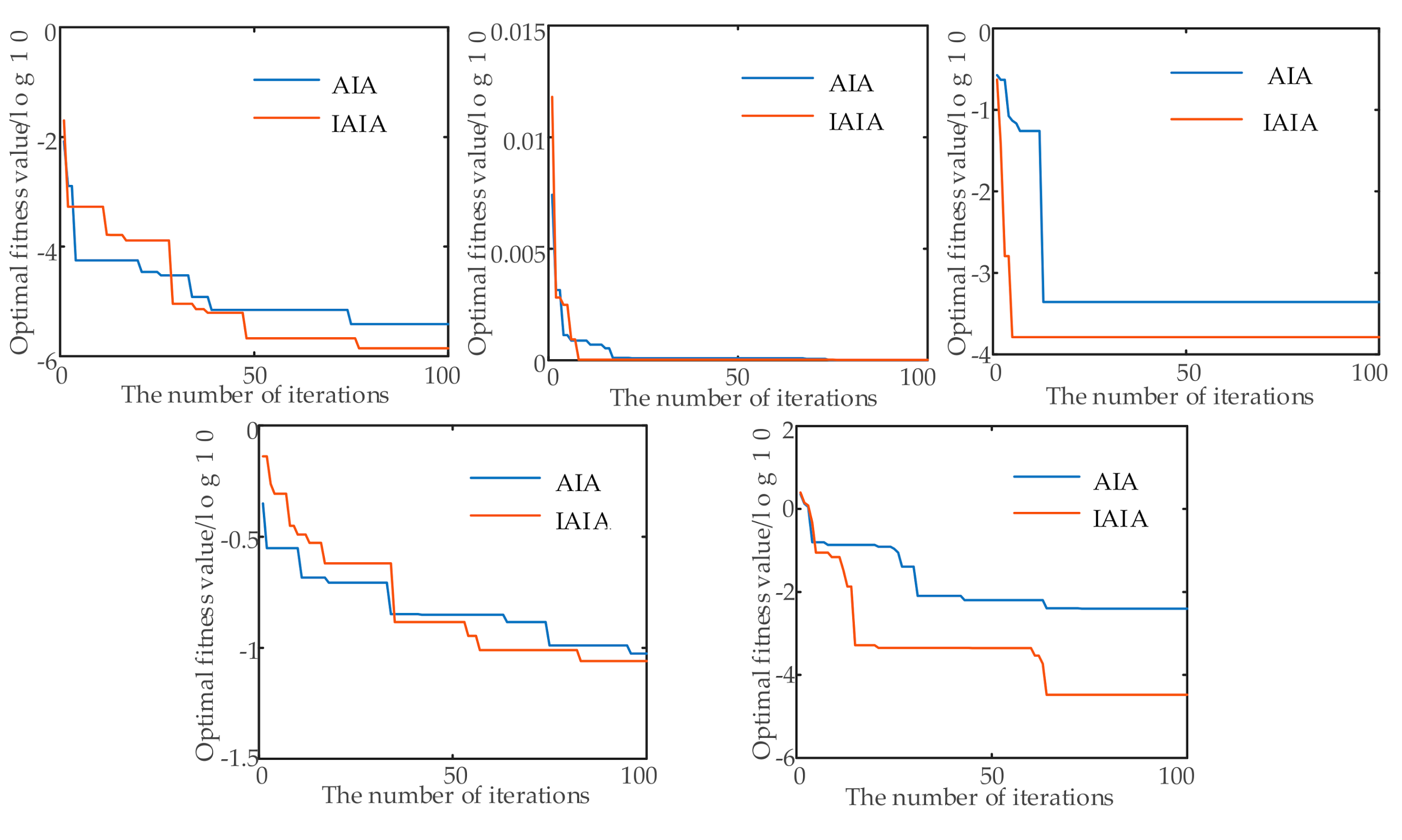
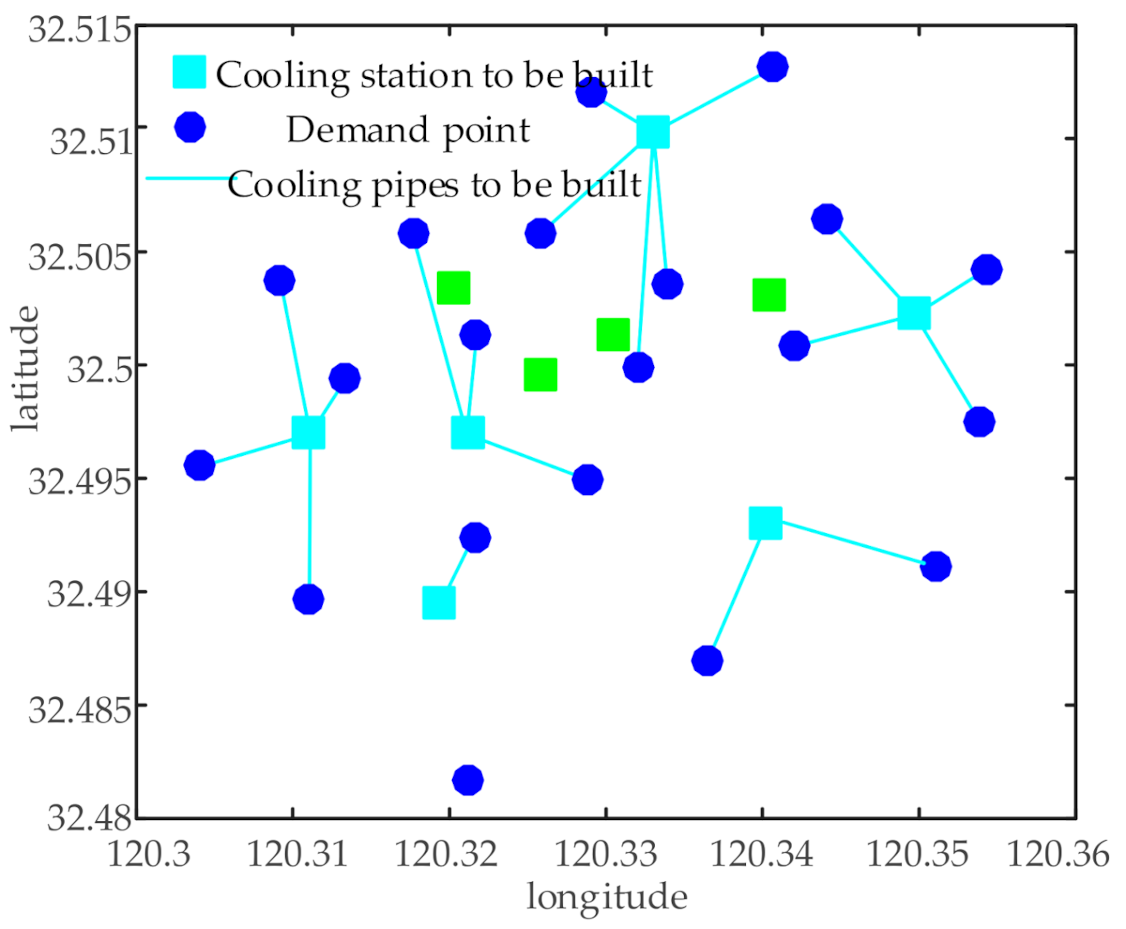
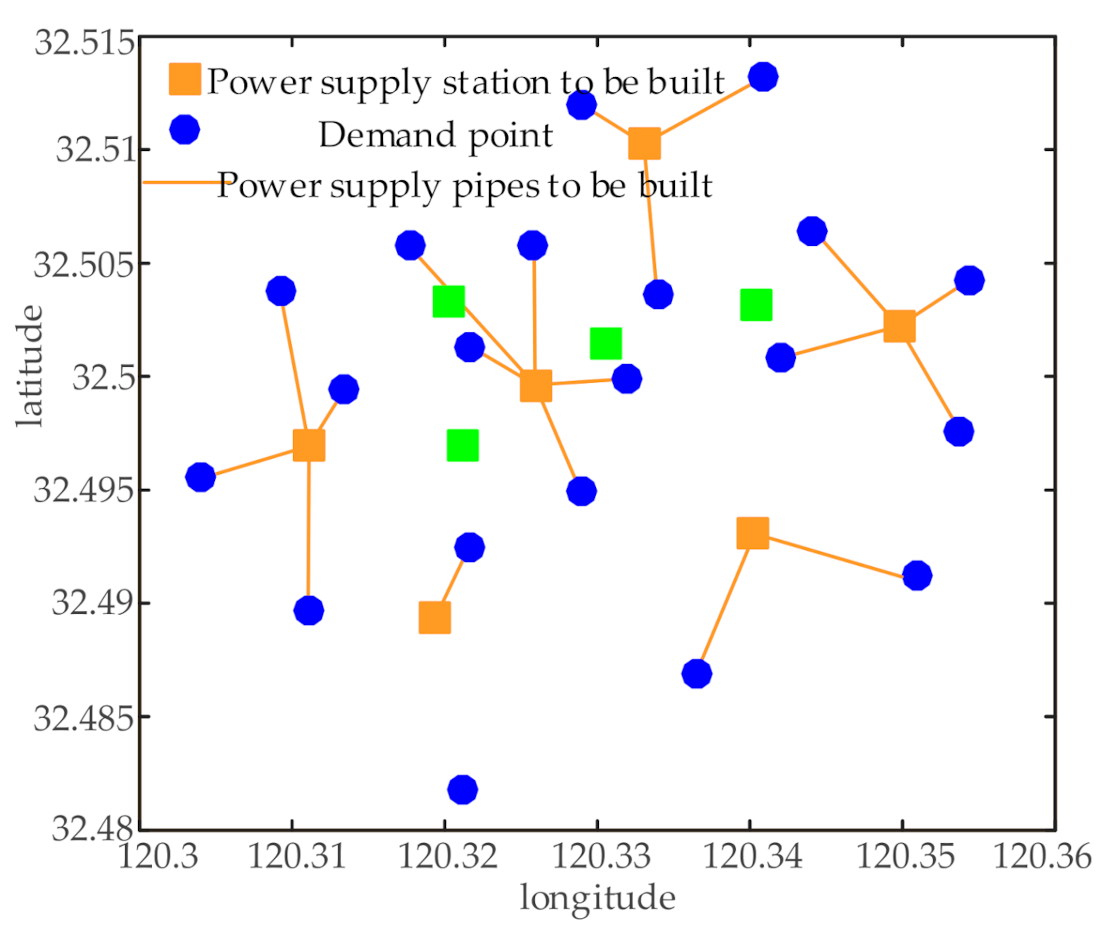
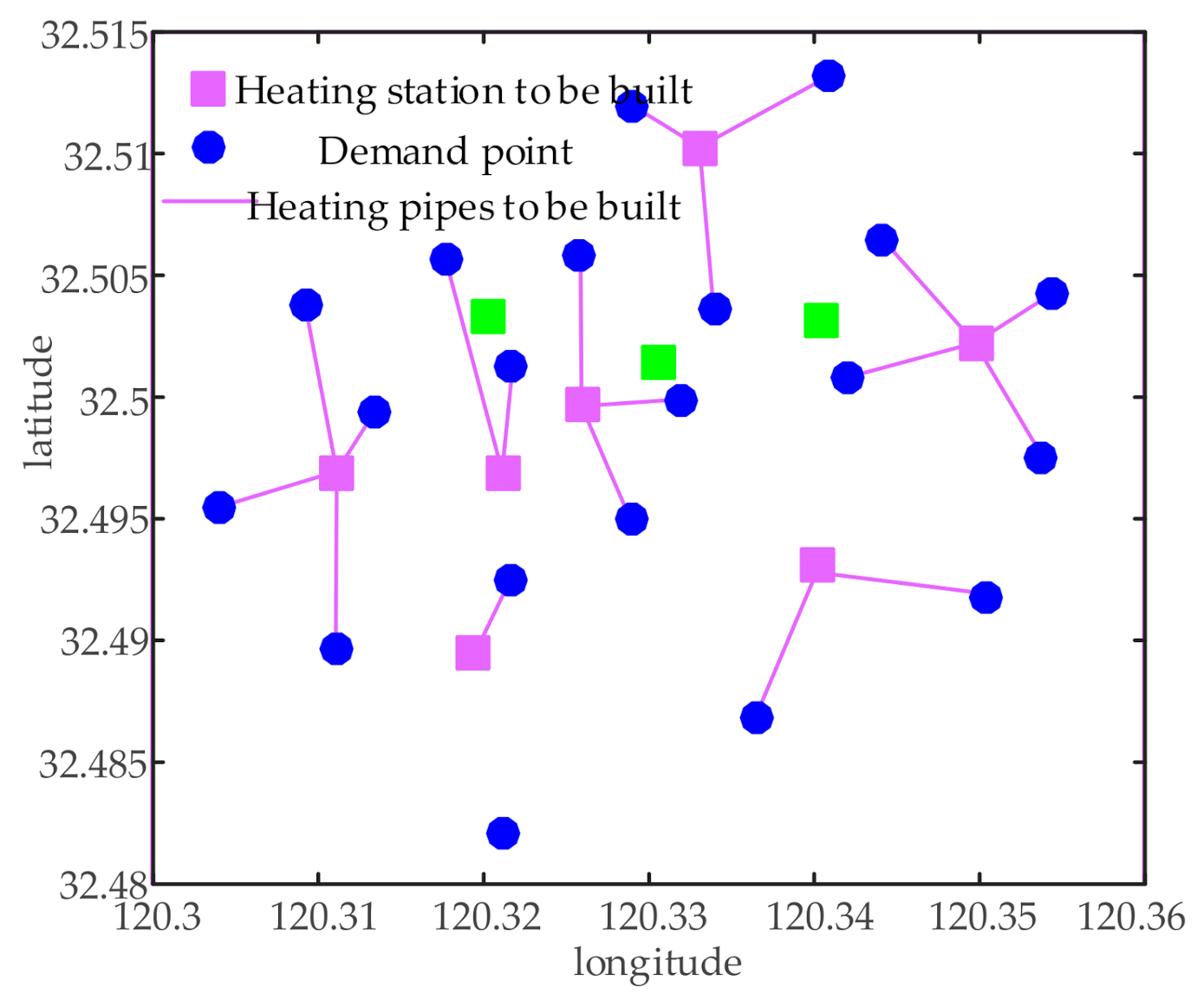
| Test Functions | Algorithm | Optimal Value | Convergence Algebra | Convergence Time/s |
|---|---|---|---|---|
| F1 | IAIA | 1.402 × 10−6 | 78 | 1.957 |
| AIA | 3.847 × 10−6 | 75 | 2.070 | |
| F2 | IAIA | 1 | 10 | 1.508 |
| AIA | 1 | 21 | 1.366 | |
| F3 | IAIA | −0.2361 | 7 | 1.437 |
| AIA | −0.1584 | 15 | 1.431 | |
| F4 | IAIA | 0.08712 | 82 | 1.373 |
| AIA | 0.09428 | 97 | 1.566 | |
| F5 | IAIA | 3.354 × 10−5 | 64 | 1.338 |
| AIA | 0.00396 | 64 | 1.519 |
| Performance Indicators | IAIA | CPLEX |
|---|---|---|
| Total objective function | 0.8416 | 0.8416 |
| Computation time/s | 123.36 | 169.81 |
| Convergence algebra | 7 | 9 |
| Related Parameters | Comprehensive Decision Planning | Conventional Decentralized Planning |
|---|---|---|
| Number of energy supply stations | 7 | 19 |
| Number of energy supply pipes | 41 | 57 |
| Investment costs/ten thousand RMB | 897.847 | 1662.326 |
| Operation and maintenance cost/ten thousand RMB·year−1 | 139.947 | 184.354 |
| Site and pipe coverage | 120% | 95% |
| Transmission load capacity of pipe network/MW·km | 18,110.45 | 14,708.05 |
| Proportion of Weights | f1 | f2 | f3 | F |
|---|---|---|---|---|
| (0.8, 0.1, 0.1) | 0.9 | 0.35 | 0.3353 | 0.7885 |
| (0.1, 0.8, 0.1) | 0.4 | 0.95 | 0.9539 | 0.8954 |
| (0.1, 0.1, 0.8) | 0.4 | 0.95 | 0.9539 | 0.8981 |
| (0.33, 0.34, 0.33) | 0.4 | 0.90 | 0.9246 | 0.7431 |
© 2020 by the authors. Licensee MDPI, Basel, Switzerland. This article is an open access article distributed under the terms and conditions of the Creative Commons Attribution (CC BY) license (http://creativecommons.org/licenses/by/4.0/).
Share and Cite
Xu, Y.; Zhang, J. Regional Integrated Energy Site Layout Optimization Based on Improved Artificial Immune Algorithm. Energies 2020, 13, 4381. https://doi.org/10.3390/en13174381
Xu Y, Zhang J. Regional Integrated Energy Site Layout Optimization Based on Improved Artificial Immune Algorithm. Energies. 2020; 13(17):4381. https://doi.org/10.3390/en13174381
Chicago/Turabian StyleXu, Yan, and Jianhao Zhang. 2020. "Regional Integrated Energy Site Layout Optimization Based on Improved Artificial Immune Algorithm" Energies 13, no. 17: 4381. https://doi.org/10.3390/en13174381
APA StyleXu, Y., & Zhang, J. (2020). Regional Integrated Energy Site Layout Optimization Based on Improved Artificial Immune Algorithm. Energies, 13(17), 4381. https://doi.org/10.3390/en13174381





